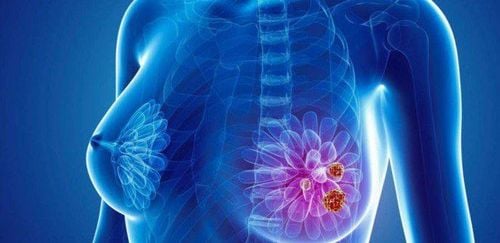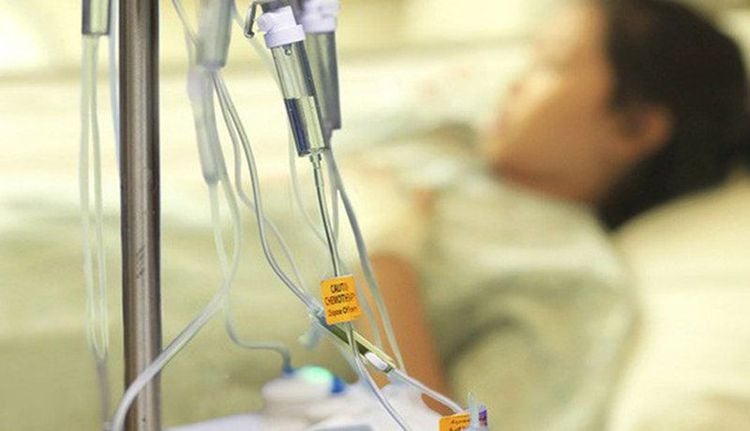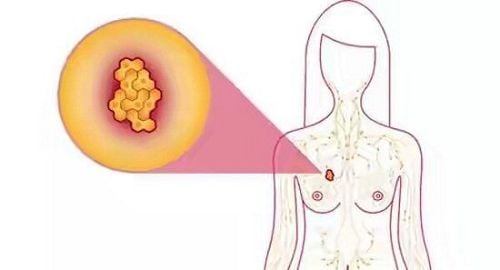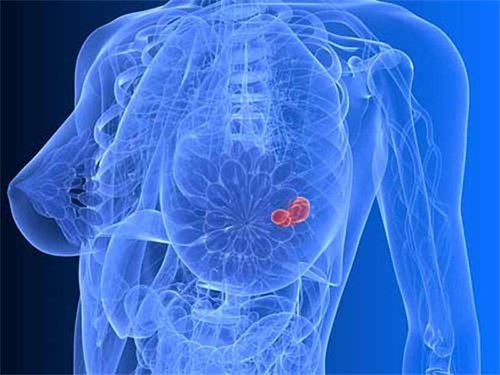This is an automatically translated article.
Stage 4 breast cancer is considered late stage breast cancer because then the cancer cells have spread to other organs of the body such as bones, brain, liver and lungs. The treatment of patients with advanced breast cancer is quite difficult and the prognosis depends on the individual patient case.
1. What is late stage breast cancer?
Late-stage breast cancer (also known as metastatic, secondary, or stage IV breast cancer) refers to cancer that has spread (or metastasized) beyond the breast to other parts of the body. Common sites of breast cancer spread include the bones, liver, lungs, and brain. However, breast cancer can also spread to other organs.
The majority of people diagnosed with metastatic breast cancer have been previously diagnosed with earlier stage breast cancer. However, for some people, a diagnosis of metastatic breast cancer is made in the first place (this is also called metastatic breast cancer de novo).

2. Symptoms of metastatic (advanced) breast cancer
Possible symptoms of advanced breast cancer are listed below. Symptoms will depend on the part(s) of the body affected and can develop over a long period of time.
If breast cancer has spread to the bones, symptoms may include ongoing bone pain or pain in the bones. The pain can be aggravated by movement and makes it difficult for the patient to sleep at night. If breast cancer has spread to the liver, symptoms may include loss of appetite, pain in the liver (right upper quadrant) or jaundice (yellowing of the skin or conjunctiva of the eyes). If breast cancer has spread to the lungs, symptoms may include shortness of breath, a dry cough, chest pain, or a feeling of heaviness in the chest. If breast cancer has spread to the brain, symptoms may include persistent headache, nausea (feeling nauseous), vomiting, seizures (edema), blurred vision, weakness in a part of your body, or changes in your body. change personality. When identifying symptoms, it is important to note that many of the symptoms listed above are signs of many other conditions that are common and may not be related to breast cancer. For example, bone pain could be a sign of arthritis, and a cough could be a symptom of a cold or flu.
However, if you are concerned about any of these symptoms or if symptoms persist, you should discuss this with your doctor to determine the cause as soon as possible.
Trắc nghiệm: Những lầm tưởng và sự thật về ung thư vú
Ung thư vú có tỷ lệ tử vong cao nhất ở nữ giới khiến họ rất lo sợ bản thân mắc phải căn bệnh này. Tuy nhiên, không ít chị em có những hiểu biết thái quá về ung thư vú. Thử sức cùng bài trắc nghiệm sau sẽ giúp bạn loại bỏ được những nghi ngờ không đúng về căn bệnh này.
Bài dịch từ: webmd.com
3. Stage 4 breast cancer survival rates
According to the US National Cancer Institute, an estimated 27 percent of people in the United States live at least 5 years after being diagnosed with stage 4 breast cancer.
Many factors can affect the life expectancy and quality of life of patients with breast cancer. Depending on the classification of breast cancer, there are different prognosis. Some forms of malignancy and some have fewer treatment options than others. For this reason, the survival prognosis depends on each individual case.
Higher survival rates are also related to the extent and location of metastases. In other words, survival may be better if the cancer only metastasizes to the bones than if the cancer is in the bones and lungs.
Seeking immediate treatment, such as chemotherapy, surgery or hormone therapy, can help improve the patient's prognosis. Making healthy lifestyle choices can also improve your chances of survival.
Facing a diagnosis of terminal or metastatic breast cancer can be very difficult and a huge emotional shock to anyone. However, there are many organizations that can help provide emotional and physical support to women diagnosed with metastatic breast cancer. When faced with terminal breast cancer, spirituality is also an important factor that helps improve treatment for patients.
4. Treatment of late stage breast cancer
Treatment for metastatic breast cancer is aimed at controlling the growth and spread of the cancer, reducing symptoms, reducing pain, and improving or maintaining quality of life.
Treatment options for metastatic breast cancer are similar to those of primary breast cancer and may include surgery, radiation therapy, chemotherapy, endocrine therapy, and/or targeted therapy, depending on location and molecular structure of the cancer. Treatment can shrink or slow tumor growth, ease symptoms, and help women live longer.
4.1. Systemic (drug) treatments for stage IV breast cancer
Treatment is usually maintained until the cancer recurs or until the side effects become unacceptable. If this happens, other medications may be tried. The drugs used for stage IV breast cancer depend on the hormone receptor status and the HER2 status of the cancer:
4.1.1. Hormone receptor positive cancer
Patients with hormone receptor-positive cancer (estrogen receptor positive or progesterone receptor positive) are usually pretreated with hormone therapy (tamoxifen or an inhibitor of aromatase). This medication may be combined with a targeted drug such as a CDK4/6 inhibitor, everolimus, or a PI3K inhibitor.
Patients who are not yet postmenopausal are usually treated with tamoxifen or with drugs that stop the ovaries from making hormones along with other medicines. Because hormone therapy can take months to work, chemotherapy is often the first line of treatment for patients with severe problems from metastatic cancer, such as breathing problems. .
4.1.2. Hormone receptor negative cancer
Chemotherapy is the mainstay of treatment for women with hormone receptor negative cancer (ER negative and PR negative), because hormone therapy is not helpful for these cancers.
4 .1.3. HER2-positive cancer
Trastuzumab (Herceptin) may help patients with HER2-positive cancer live longer if it is given with chemotherapy or with other drugs such as hormone therapy or other drugs. other anti-HER2. Pertuzumab (Perjeta), another targeted drug, may also be added. Another option is the targeted drug lapatinib (which can be used along with certain chemotherapy drugs or hormone therapy) or ado-trastuzumab emtansine (Kadcyla).
4.1.4. HER2-negative cancer in women with a BRCA gene mutation
These women are usually treated with chemotherapy (and hormone therapy, if the cancer is hormone receptor-positive). One option after chemotherapy is treatment with a targeted drug called a PARP inhibitor, such as olaparib or talazoparib.
4.1.5. HER2-negative breast cancer in women with the PIK3CA mutation
Alpelisib is a targeted drug known as a PI3K inhibitor that can be used together with fulvestrant to treat postmenopausal women with breast cancer. hormone receptor-positive breast cancer.
4.1.6. Triple-negative breast cancer
Atezolizumab can be used together with Abraxane (albumin-bound paclitaxel) in people with advanced triple-negative breast cancer whose tumors produce the PD-L1 protein. (PD-L1 protein is found to be about 20% of triple-negative breast cancers.) For women with TNBC and BRCA mutations whose cancer no longer responds to cancer chemotherapy drugs For conventional breast cancer, other chemotherapy called platinum drugs (such as cisplatin or carboplatin) may be considered.

4.2. Local Treatments for Stage IV Breast Cancer
Although systemic drugs are the mainstay of treatment for stage IV breast cancer, local and regional treatments such as surgery, radiation, or Regional chemotherapy is also sometimes used. These drugs can help treat breast cancer in a specific part of the body, but they are very unlikely to eliminate all of the cancer. These treatments are more likely to be used to help prevent or treat symptoms or complications of cancer.
Radiation therapy and/or surgery may also be used in certain cases, such as:
When a breast tumor causes an open wound in the breast (or chest) To treat a small number of metastases in a certain area, such as the brain To help prevent fractures When an area of cancer has spread on the spinal cord To treat a blockage of a blood vessel in the liver To relieve pain or other symptoms In some cases In combination, topical chemotherapy (where the drug is delivered directly into a certain area, such as into the fluid around the brain and spinal cord) may also be helpful.
4.3. Treatment to relieve symptoms of advanced breast cancer
Treatment to relieve symptoms depends on where the cancer has spread. For example, pain from bone metastases can be treated with radiation therapy, medicines called bisphosphonates such as pamidronate (Aredia) or zoledronic acid (Zometa), or the drug denosumab (Xgeva). For more, see our information on treating bone metastases.
4.3.1. Late-stage cancer that progresses during treatment
Treatment for late-stage breast cancer can often shrink or slow the growth of the cancer (sometimes for years), but after a while it does tends to stop working. Further treatment options at this point depend on several factors, including previous treatments, the location of the cancer and age, the patient's general health, and the desire to continue treatment. treat.
4.3.2. Progression while on hormone therapy
For hormone receptor-positive cancers (ER-positive or PR-positive) being treated with hormone therapy, switching to the hormone therapy type other will sometimes be useful. For example, if letrozole (Femara) or anastrozole (Arimidex) have been given, using exemestane, possibly with everolimus (Afinitor), may be an option. Another option might be to use a fulvestrant (Faslodex) or an aromatase inhibitor (such as letrozole), along with a CDK inhibitor. If the cancer has a PIK3CA mutation and grows while using an aromatase inhibitor, optimal drug use with alpelisib may be considered. If the cancer no longer responds to any hormone medications, chemotherapy is usually the next step.
4.3.3. Progress with chemotherapy
If the cancer no longer responds to one chemotherapy regimen, trying another regimen may be helpful. Many different drugs and combinations can be used to treat breast cancer. However, as the cancer progresses during treatment, subsequent treatment will be less effective.
4.3.4. Progressing on HER2 Therapy
HER2-positive cancers that no longer respond to trastuzumab (Herceptin) may react with other drugs that target the HER2 protein. Options for patients with HER2-positive cancer may include:
Pertuzumab (Perjeta) with chemotherapy and trastuzumab Ado-trastuzumab emtansine (Kadcyla) Fam-trastuzumab deruxtecan (Enhertu) Lapatinib (Tykerb) and chemotherapy drugs capecitabine Lapatinib and an aromatase inhibitor (for hormone receptor-positive cancers) neratinib (Nerlynx) and the chemotherapy drug capecitabine (this combination may be helpful for cancers that have spread to the brain) Tucatinib (Tukysa), trastuzumab, and the chemotherapy drug capecitabine (this combination may be helpful for cancers that have spread to the brain)

Unfortunately, cancer cells often become harder to treat and can develop drug resistance as they metastasize. According to the Australian Institute of Health and Welfare (AIHW), the five-year survival rate for metastatic breast cancer is 32%, compared with an average of 91% for all breast cancer patients. It is not possible to accurately predict the course of the disease for any individual. New treatments also continue to be developed, and some women live with metastatic breast cancer for many years.
At Vinmec International General Hospital, there is a Breast Cancer Screening Package to help detect breast cancer early even when there are no symptoms.
Breast cancer screening package at Vinmec for the following subjects:
Female customers, over 40 years old. Customers wishing to be able to screen for breast cancer Customers are at high risk of cancer – especially customers with a family history of breast cancer. Women of reproductive age, perimenopause and menopause. Women who are having symptoms of breast cancer such as: pain in the breast, lump in the breast, etc.
Please dial HOTLINE for more information or register for an appointment HERE. Download MyVinmec app to make appointments faster and to manage your bookings easily.
Reference source: nbcf.org.au












